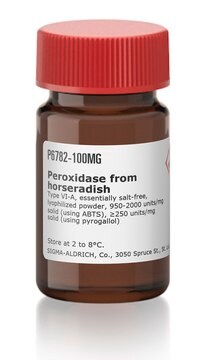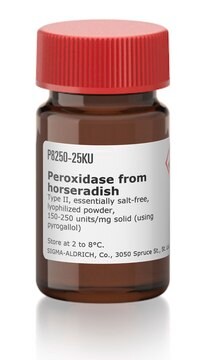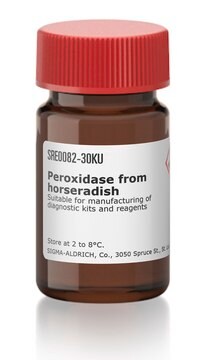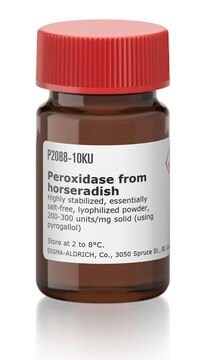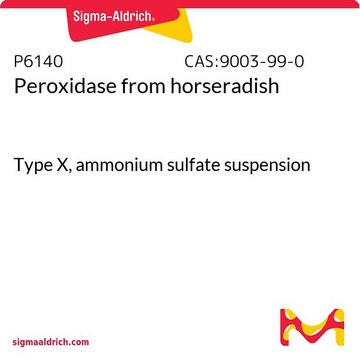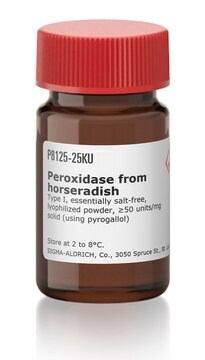General description
La peroxidasa de rábano picante se aísla de las raíces de rábano picante (Amoracia rusticana) y pertenece al grupo de ferroprotoporfirina de las peroxidasas. La HRP es un polipéptido monocatenario que contiene cuatro puentes bisulfuro. Es una glucoproteína que contiene un 18 % de carbohidratos. La composición de los carbohidratos consiste en galactosa, arabinosa, xilosa, fucosa, manosa, manosamina y galactosamina dependiendo de la isoenzima específica. Su peso molecular (~44 kDa) incluye la cadena polipeptídica (33 890 dalton), la hemina más Ca2+ (~700 dalton) y los carbohidratos (~9 400 dalton). Existen al menos siete isoenzimas de la HRP. El punto isoeléctrico de las isoenzimas de la peroxidasa de rábano picante oscila entre 3,0 y 9,0.
HRP is a single chain polypeptide containing four disulfide bridges. It is a glycoprotein containing 18% carbohydrate. The carbohydrate composition consists of galactose, arabinose, xylose, fucose, mannose, mannosamine, and galactosamine depending upon the specific isozyme. Its molecular weight (~44 kDa) includes the polypeptide chain (33,890 Daltons), hemin plus Ca2+ (~700 Daltons), and carbohydrate (~9,400 Daltons). At least seven isozymes of HRP exist. The isoelectric point for horseradish peroxidase isozymes ranges from 3.0 - 9.0.
Application
Horseradish peroxidase (HRP) is isolated from horseradish roots (Amoracia rusticana) and belongs to the ferroprotoporphyrin group of peroxidases. It is used in biochemistry applications such as western blots, ELISA and Immunohistochemistry. Horseradish peroxidase is used to amplify a weak signal and increase detectability of a target molecule, such as a protein. Product P8415, type XII, is an essentially salt free lyophilized powder. It is a further purification of product P8375. It is commonly used to determine amounts of glucose and peroxides in solution. It has been used in an aspergillus fumigatus rapid susceptibility assay.
Peroxidase from horseradish has been used to initiate peroxidase-coupled assay. It has also been used in the preparation of β-galactosidase (β-gal) stock solution.
The enzyme has been used to determine H2O2 production in tobacco BY-2 cells using a spectrofluorimetric method.
Biochem/physiol Actions
HRP readily combines with hydrogen peroxide (H2O2) and the resultant [HRP-H2O2] complex can oxidize a wide variety of hydrogen donors. The optimal pH is 6.0-6.5 and the enzyme is most stable in the pH range of 5.0-9.0. HRP can be conjugated to antibodies by several different methods including glutaraldehyde, periodate oxidation, through disulfide bonds, and also via amino and thiol directed cross-linkers. It is smaller and more stable than the enzyme labels β-galactosidase and alkaline phosphatase and hence, it is the most desired label. Also, its glycosylation leads to lower non-specific binding. It is also used for the determination of glucose and peroxides in solution.
When incubated with a substrate, horseradish peroxidase produces a coloured, fluorimetric, or luminescent derivative of the labeled molecule, allowing quantification. Horseradish peroxidase has been shown to slightly reduce the level of inhibition in a cydAB mutant. Known inhibitors are sodium azide, cyanide, L-cystine, dichromate, ethylenethiourea, hydroxylamine, sulfide, vanadate, p-aminobenzoic acid, and Cd2+, Co2+, Cu2+, Fe3+, Mn2+, Ni2+, and Pb2+ ions.
Unit Definition
Una unidad de pirogalol formará 1,0 mg de purpurogalina a partir de pirogalol en 20 segundos a pH 6,0 a 20 °C.
Preparation Note
Chromatographically purified
Analysis Note
La RZ (Reinheitszahl) es la relación de absorbancia A403/A275 determinada a 0,5-1,0 mg/ml en agua desionizada. Es una medida del contenido de hemina, no de la actividad enzimática. Incluso preparaciones con RZ elevada pueden tener una actividad enzimática baja.
Preliminary isoelectric focusing data indicates this is primarily isoenzyme C

